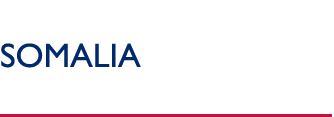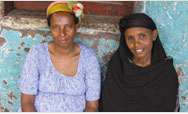 |
|
 |
 |
|
 |
 |
|
 |
 |
 |
USAID Information:
External Links:
|
|
 |
 |
|
Somalia – Complex Emergency
September 10, 2008
Situation Report #9, Fiscal Year (FY) 2008 (PDF, 50kb)
Map (PDF, 281kb)
Background
Since 1991, widespread violence, endemic poverty, and recurrent droughts and floods have generated a complex emergency in Somalia. Continued civil strife and inter-clan conflicts have complicated the humanitarian situation and limited access to affected areas. In addition, ongoing fighting since late December 2006 between the Somalia Transitional Federal Government (TFG), Ethiopian forces, and armed militias opposed to the TFG has led to a further deterioration in humanitarian conditions. As a result, approximately 476,000 Somali refugees have fled the country and more than 1.1 million internally displaced persons (IDPs) are uprooted within Somalia, including long-term IDPs as well as individuals displaced by increased fighting since February 2007.
In August 2008, the U.N. Food and Agriculture Organization (FAO) Food Security Analysis Unit (FSAU) reported that 3.2 million people are in need of humanitarian assistance, a 77 percent increase since January 2008. The combined effects of consecutive seasons of failed or poor rainfall, continuing conflict, rising inflation, massive displacement, and diarrheal disease outbreaks have severely exacerbated the food security situation and resulted in a significant increase in acute malnutrition rates, according to the 2008 U.N. Consolidated Appeals Process (CAP) for Somalia. U.N. and partner agencies are coordinating efforts to improve access, but insecurity and targeted attacks against relief staff hinder the provision of emergency assistance to affected populations.
On October 3, 2007, U.S. Ambassador to Kenya Michael E. Ranneberger redeclared a disaster due to the ongoing complex emergency in Somalia. To date in FY 2008, the U.S. Government (USG) has provided nearly $269 million for emergency food assistance, health, nutrition, agriculture and food security, livelihoods support, humanitarian coordination, protection, and water, sanitation, and hygiene programs, as well as refugee assistance and air operations.
NUMBERS AT A GLANCE
| Total Population in Need of Emergency Assistance |
3.2 million |
FSAU – Aug. 2008 |
| Urban Caseload |
705,000 |
FSAU – Aug. 2008 |
| IDPs since February 2007 |
870,000 |
FSAU – Aug. 2008 |
| Long-Term IDPs |
275,000 |
FSAU – Aug. 2008 |
| Rural Caseload |
1,395,000 |
FSAU – Aug. 2008 |
| Somali Refugees in Djibouti, Kenya, Ethiopia, and Yemen |
334,000 |
UNHCR(1) Global Trends Report – June 2008 |
|
FY 2008 HUMANITARIAN FUNDING
| USAID/OFDA Humanitarian Assistance to Somalia: |
$51,202,443 |
| USAID/FFP (2) Humanitarian Assistance to Somalia: |
$197,415,500 |
| State/PRM (3) Humanitarian Assistance to Somalia: |
$20,100,000 |
| Total USAID and State Humanitarian Assistance to Somalia: |
$268,717,943 |
|
|
|
|
Current Situation
On August 28, the U.N. hosted the 2009 CAP consultations for Puntland in Garoowe, Nugal Region. The group developed possible security scenarios, associated impacts on humanitarian operations, and appropriate responses to ensure continuing humanitarian aid provision. The group also completed the 2009 cluster response plans
for Puntland. The final and cumulative workshop took place on September 8 and 9 in Nairobi to formally complete scenarios, priorities, and implementation strategies for all of Somalia.
The FSAU April to July gu rains assessment report released on August 26 identifies 3.2 million people, or 43 percent of the total population of Somalia, in need
of emergency humanitarian assistance, up from 2.6 million people in April. The total number of affected individuals includes nearly 1.4 million people living in rural areas and 705,000 urban dwellers. The revised humanitarian caseload represents a 77 percent increase since January 2008, with the largest increase occurring among rural populations in south and central Somalia, according to FSAU.
On August 20, the U.N. Security Council extended the mandate of the African Union Mission in Somalia (AMISOM) for an additional six months. Currently, AMISOM has approximately 1,600 peacekeeping troops from Uganda and Burundi, with another 850 peacekeepers scheduled to arrive from Nigeria in the coming weeks.
A USAID/OFDA Disaster Assistance Response Team based in Nairobi continues to address evolving needs related to the regional drought and food security crisis in the Horn of Africa. USAID/OFDA staff are monitoring conditions, identifying priority needs, and facilitating coordination and information sharing among international relief organizations.
Security and Population Movements
The security situation continues to worsen in Somalia, particularly for humanitarian workers. Recent security incidents have included the death of a U.N. World Food Program (WFP) Somali humanitarian worker, serious injury of a U.N. World Health Organization (WHO) Somali staff member, and the abduction of two Western journalists, according to international media sources. On September 3, a suspected failed carjacking resulted in the injury of one WFP relief worker, according to the U.N. Office for the Coordination of Humanitarian Affairs (OCHA).
On September 2, Médecins Sans Frontières announced the cessation of medical activities in one clinic in the Wardigley/Hodan area of Mogadishu following a further deterioration in security. The health clinic provided services to children under the age of 12 and pregnant mothers.
The ongoing deterioration of security conditions in Somalia is resulting in new displacement and is significantly undermining humanitarian response efforts. As of August 26, FSAU reported 870,000 newly displaced people since last year, bringing the total number of IDPs to more than 1.1 million.
More than 35,000 people haven been displaced from areas in and around Mogadishu since June 1, including 23,000 IDPs in the town of Afgooye between August 15 and 18, according to OCHA. In addition, intense fighting in the southern port city of Kismayo between August 20 and 22 resulted in more than 100 deaths and the displacement of an estimated 35,000 individuals.
Health Nutrition
According to recent nutrition surveys and rapid nutrition assessments, malnutrition rates for children under the age of five are rapidly increasing. The U.N. Children’s Fund (UNICEF) and non-governmental organizations report increased admissions to therapeutic feeding programs. The temporary interruption of therapeutic and supplemental feeding programs due to insecurity has further exacerbated the situation.
On August 15, UNICEF and FSAU reported that an estimated 180,000 children residing in south central Somalia and IDP camps throughout the country are acutely malnourished, including 26,000 children that are severely malnourished and in need of immediate life-saving assistance.
UNICEF is planning to provide measles vaccinations and vitamin A supplements through a child health campaign in October to an estimated 1.5 million children under the age of five.
In August, USAID/OFDA committed more than $4.1 million to UNICEF to support nutrition programs in Mogadishu and Lower Shabelle Region. To date in FY 2008, USAID/OFDA has provided nearly $9.4 million for nutrition activities in Somalia.
Emergency Food Assistance
Due to ongoing food commodity shortfalls, WFP has reduced the full food basket of 2,100 kilocalories per person per day to 75 percent for the third consecutive month.
On August 25, U.S. Central Command (CENTCOM) announced the establishment of a Maritime Security Patrol Area in the Gulf of Aden. A force of coalition navy ships will patrol the area by sea, while aircraft will patrol from the airspace above. CENTCOM recommends that all commercial vessels sailing near the Somali coast use the corridor to avoid contact with armed pirates.
The Government of Canada is currently providing naval escorts for WFP shipments of emergency relief commodities to Somalia through September 27. According to media reports, the European Union is planning a mechanism to help coordinate the protection of vessels from piracy off the coast of Somalia, particularly WFP food aid shipments, and is considering a more substantial operation at a later stage.
The USG continues to coordinate with international partners on potential counter-piracy efforts and to secure long-term naval escorts for WFP humanitarian shipments to Somalia.
Somalia Complex Emergency – September 10, 2008
During the week of August 11, USAID/OFDA committed more than $20 million for the regional purchase of 26,107 metric tons (MT) of maize to support WFP food aid operations targeting an estimated 2 million beneficiaries.
To date, USAID/FFP has provided more than 211,000 MT of P.L. 480 Title II emergency food assistance, valued at nearly $198 million. In total, USAID/FFP assistance is benefiting approximately 1.7 million Somalis countrywide.
Agriculture and Food Security
FSAU reports that due to currency depreciation, a high dependence on imported commodities, high international food and fuel prices, and low cereal stocks and production, food and non-food prices have increased by up to 370 percent over the last six months and 700 percent over the last year. In southern Somalia, sorghum prices increased nearly six fold over the last year, from $1.56 to $9.20 per kg.
To date in FY 2008, USAID/OFDA has provided nearly $2.5 million for agriculture and food security activities countrywide, including programs to facilitate the diversification of agricultural-based livelihoods and enhance livestock disease preparedness and mitigation efforts.
For detailed information on U.S. Government humanitarian assistance to Somalia, please see Somalia Complex Emergency - Situation Report #9 (pdf, 49kb)
Back to Top ^
|


